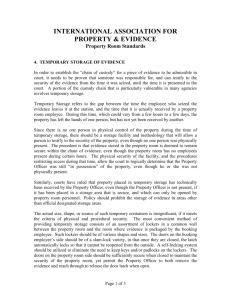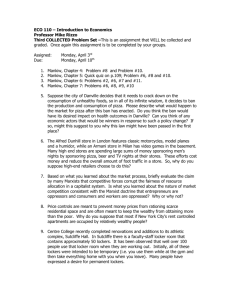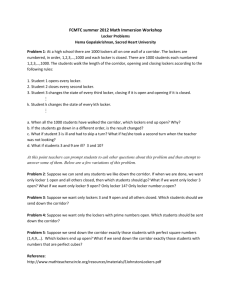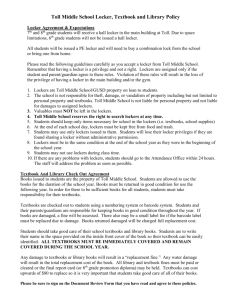IAPE STANDARDS SECTION 6 – TEMPORARY STORAGE
advertisement
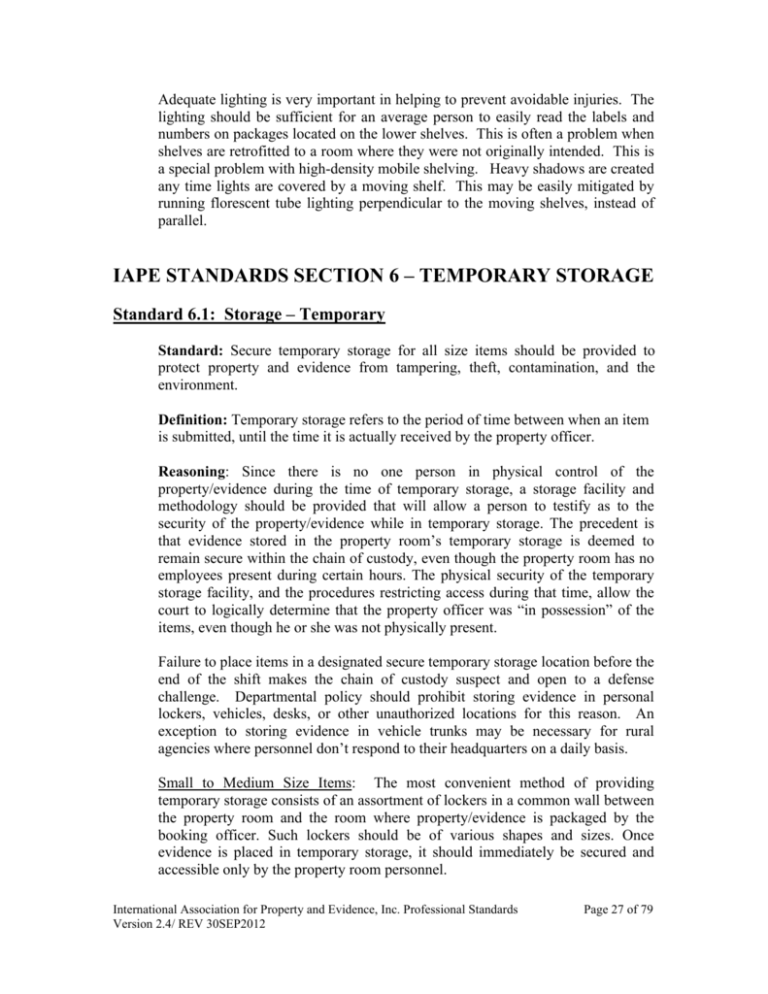
Adequate lighting is very important in helping to prevent avoidable injuries. The lighting should be sufficient for an average person to easily read the labels and numbers on packages located on the lower shelves. This is often a problem when shelves are retrofitted to a room where they were not originally intended. This is a special problem with high-density mobile shelving. Heavy shadows are created any time lights are covered by a moving shelf. This may be easily mitigated by running florescent tube lighting perpendicular to the moving shelves, instead of parallel. IAPE STANDARDS SECTION 6 – TEMPORARY STORAGE Standard 6.1: Storage – Temporary Standard: Secure temporary storage for all size items should be provided to protect property and evidence from tampering, theft, contamination, and the environment. Definition: Temporary storage refers to the period of time between when an item is submitted, until the time it is actually received by the property officer. Reasoning: Since there is no one person in physical control of the property/evidence during the time of temporary storage, a storage facility and methodology should be provided that will allow a person to testify as to the security of the property/evidence while in temporary storage. The precedent is that evidence stored in the property room’s temporary storage is deemed to remain secure within the chain of custody, even though the property room has no employees present during certain hours. The physical security of the temporary storage facility, and the procedures restricting access during that time, allow the court to logically determine that the property officer was “in possession” of the items, even though he or she was not physically present. Failure to place items in a designated secure temporary storage location before the end of the shift makes the chain of custody suspect and open to a defense challenge. Departmental policy should prohibit storing evidence in personal lockers, vehicles, desks, or other unauthorized locations for this reason. An exception to storing evidence in vehicle trunks may be necessary for rural agencies where personnel don’t respond to their headquarters on a daily basis. Small to Medium Size Items: The most convenient method of providing temporary storage consists of an assortment of lockers in a common wall between the property room and the room where property/evidence is packaged by the booking officer. Such lockers should be of various shapes and sizes. Once evidence is placed in temporary storage, it should immediately be secured and accessible only by the property room personnel. International Association for Property and Evidence, Inc. Professional Standards Version 2.4/ REV 30SEP2012 Page 27 of 79 Oversized or Bulky Items: An area designated for the temporary storage of oversized or bulky items is recommended so that such items are not commingled with other evidence items and are safeguarded from potential tampering, theft, or the environment. Security wire mesh or chain link cages are effective for securing large items. The most effective method of locking temporary storage areas or lockers is to use a self-locking system that once secured, may not be opened by anyone other than the property officer. Padlocks should be secured to the locker frame to prevent it being removed and a having a key made. The key code on the bottom of a padlock should be removed before being placing it into service. Keys should not be left in empty lockers to prevent a key being removed and duplicated. Biohazard Items: Secure temporary storage of biohazard items is recommended. Some items may require drying if still in a wet or moist state. A lockable drying locker or cabinet is recommended in order to dry body fluids. This location should be easily decontaminated and made of a non-porous material. A decontamination log should be maintained to document when the location was last cleaned. In most instances, wet body-fluids should be dried and subsequently frozen as soon as practical in order to conform with forensic laboratory standards. Check with the local crime lab for their requirements. Blood/Urine: Check with the crime lab to verify if wet blood and urine should be refrigerated or may temporarily stored at room temperature. The use of “grey top” blood vials with preservative may still require refrigeration for accurate toxicology tests. Hazardous Materials/Flammables: A temporary storage location for small quantities or samples of hazardous materials should be provided. This location should be open to the outside where any escaping fumes will not enter the building where it could become a hazard to employees. All hazardous materials should generally be stored in an airtight container. The use of an “explosion resistant” cabinet is highly recommended. Large quantities of such hazardous materials should not be stored in the property room. Consider saving a sample of the larger quantity for scientific analysis and obtaining a court order through proper channels to dispose of the remainder in most cases. The Fire Department should be consulted for acceptable storage methods. Perishables: As a general rule, perishables should not be stored in the Property room. However, there are circumstances that may require such storage. For this instance, a dedicated refrigerator and a freezer should be made available for temporary storage. Such a refrigerator or freezer should be designed with lockable compartments or doors to protect against commingling evidence from different cases, or potential tampering or theft. International Association for Property and Evidence, Inc. Professional Standards Version 2.4/ REV 30SEP2012 Page 28 of 79 Drop Slots: A drop-slot in a designated locker is one of the most effective methods of securing small items in a method that does not use all available unlocked lockers. Small items may include, but are not limited to; film, latent prints, tapes, magnetic media, CDs, DVDs, etc. Trouble Locker: Consider designating one locker as a “trouble locker” to hold improperly documented or packaged items until the submitting officer can make corrections. IAPE STANDARDS SECTION 7: LONG-TERM STORAGE Standard 7.1: Storage: Long-Term Standard: Buildings, rooms and shelves/bins should be provided for the longterm storage of property/evidence for the duration of time it is held in the custody of the property room. Definition: A long-term location is designated to keep items retained in the custody of the agency until they are diverted, sold, released or destroyed. Reasoning: Appropriate storage facilities are needed to accommodate the longterm storage of property and evidence. Building(s) or rooms should be large enough to secure all evidence. Additionally, enhanced security storage should be acquired for the storage of high profile items such as firearms, money and drugs. Standard 7.2: Storage - Evidence Standard: Evidence held in the custody of a law enforcement agency should be stored in a manner that facilitates efficient use of space, permits quick retrieval, minimizes safety hazards, prevents cross-contamination and facilitates conducting an inventory. Definition: A long-term storage of evidence is a place designated to keep evidence items segregated from other types of property retained in the custody of the agency until they are disposed, sold, released or destroyed. Reasoning: Evidence may be held in the property room anywhere from just a few days to years. Most items need to have a long-term location designated for various categories of evidence, until the item reaches its final disposition for release, destruction, auction or diversion. Envelope Storage: Storage space should be allocated for various sizes of envelopes designated for small items. These envelopes should be filed by the tracking number. Providing shelves for different size envelopes make for easy storage, retrieval and inventories. International Association for Property and Evidence, Inc. Professional Standards Version 2.4/ REV 30SEP2012 Page 29 of 79
